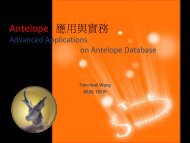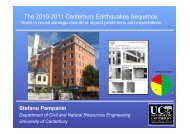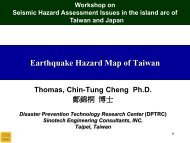Hard lessons for hazard, risk and socio-economic impacts of the ...
Hard lessons for hazard, risk and socio-economic impacts of the ...
Hard lessons for hazard, risk and socio-economic impacts of the ...
Create successful ePaper yourself
Turn your PDF publications into a flip-book with our unique Google optimized e-Paper software.
Observations from Canterbury Rein<strong>for</strong>ce GEM’s Vision<br />
Kelvin Berryman – Director, Natural Hazards Research Plat<strong>for</strong>m, New Zeal<strong>and</strong><br />
22 Feb, 2011<br />
GEM semi-annual meeting, Taipei, June 2012<br />
Natural Hazards Research GNS Science Plat<strong>for</strong>m
An update on <strong>the</strong> Canterbury earthquake<br />
sequence <strong>and</strong> possible insights <strong>for</strong> GEM<br />
• Characteristics <strong>of</strong> <strong>the</strong> earthquake sequence <strong>and</strong> <strong>impacts</strong><br />
• Characteristics <strong>of</strong> <strong>the</strong> city <strong>and</strong> regional economy<br />
• Response <strong>and</strong> recovery actions – role <strong>of</strong> government<br />
• Socio-<strong>economic</strong> insights<br />
• Rebuilding a more resilient city<br />
• Rebuilding – impediments <strong>and</strong> opportunities<br />
GEM semi-annual meeting, Taipei, June 2012<br />
Natural Hazards Research GNS Plat<strong>for</strong>m Science
GEM semi-annual meeting, Taipei, June 2012<br />
Natural Hazards Research GNS Plat<strong>for</strong>m Science
An update on <strong>the</strong><br />
Canterbury earthquake sequence<br />
• The regional context<br />
• The continuing aftershocks: <strong>the</strong>ir frequency <strong>and</strong> strength<br />
• Why was <strong>the</strong>re so much damage to <strong>the</strong> Canterbury region in<br />
Feb 2011 <strong>and</strong> subsequently<br />
• Earthquake <strong>for</strong>ecast probabilities – what do <strong>the</strong>y mean<br />
Hazard in Canterbury is moderate by NZ st<strong>and</strong>ards –10% in 50 yr PGA <strong>of</strong> ~ 0.3 g<br />
GEM semi-annual meeting, Taipei, June 2012<br />
Natural Hazards Research GNS Plat<strong>for</strong>m Science
How normal or abnormal is <strong>the</strong> sequence<br />
GEM semi-annual meeting, Taipei, June 2012<br />
Natural Hazards Research GNS Plat<strong>for</strong>m Science
Ground Shaking<br />
GEM semi-annual meeting, Taipei, June 2012<br />
Natural Hazards Research GNS Plat<strong>for</strong>m Science
Features <strong>of</strong> <strong>the</strong> earthquake sequence in <strong>the</strong> NZ context<br />
A large (<strong>for</strong> NZ) natural <strong>hazard</strong> event in a small economy<br />
• 10% <strong>of</strong> NZ’s 4.5 million people directly impacted<br />
• Total loss estimates c. $30b NZD – about 8-10% GDP<br />
• NZ’s economy about <strong>the</strong> same size as Munich-Re or IBM annual revenue<br />
Events such as this have <strong>the</strong> possibility <strong>of</strong> irreparably damaging <strong>the</strong> economy<br />
<strong>of</strong> small or developing nations<br />
Regional economy is strong (based on agriculture)<br />
• Port, airport, road <strong>and</strong> rail networks had very little downtime<br />
• 95% <strong>of</strong> businesses are still operating albeit with downturn in tourism, education,<br />
<strong>and</strong> hospitality<br />
• Some migration away from Canterbury especially initially, now about 10,000<br />
persons, but 30,000 new workers needed <strong>for</strong> rebuild – communities remained<br />
largely intact, even in <strong>the</strong> “residential red zone”<br />
• Early government support <strong>for</strong> local business continuity<br />
A city cannot operate in isolation from its hinterl<strong>and</strong>. Supply chains <strong>and</strong><br />
infrastructure are critical. There was no need <strong>for</strong> widespread evacuation in<br />
Christchurch <strong>and</strong> this is a key tipping-point in regional <strong>economic</strong> resilience<br />
GEM semi-annual meeting, Taipei, June 2012<br />
Natural Hazards Research GNS Plat<strong>for</strong>m Science
Canterbury Community Resilience<br />
GEM semi-annual meeting, Taipei, June 2012<br />
Natural Hazards Research GNS Plat<strong>for</strong>m Science
An extended sequence <strong>of</strong> events<br />
4 September 22 February 13 June 13 23 December<br />
2010 2011 2011 2011<br />
Mag (M w ) 7.1 6.2 6.0 5.9<br />
Epicentre 1 30 km W 10 km SE 10 km SE 10 km E<br />
Time 2 4:36 am 12.51 pm 2.20 pm 3.18 pm<br />
Max PGA 3 0.6g (0.3g CBD) 2.2g (0.8g CBD) 2.2g (0.4g CBD) 0.96g 4 (0.25g CBD)<br />
Casualties 0 fatalities 185 fatalities 0 fatalities 0 fatalities<br />
Building<br />
Damage<br />
To older concrete<br />
& URM<br />
Liquefaction Widespread in<br />
eastern suburbs<br />
All pre-1970’s &<br />
several modern<br />
buildings with<br />
eccentric design<br />
Extreme damage in<br />
many eastern<br />
Christchurch<br />
suburbs<br />
Fur<strong>the</strong>r residential<br />
damage in Port<br />
Hills & already<br />
damaged CBD<br />
buildings<br />
Fur<strong>the</strong>r damage<br />
in eastern<br />
Christchurch<br />
suburbs<br />
Minor, but several<br />
instances <strong>of</strong><br />
progressive failure<br />
Minor damage in<br />
eastern<br />
Christchurch<br />
suburbs<br />
Cost 5 4-5 billion 15-20 billion c. 1.5 billion c. 26 million<br />
• Long <strong>and</strong> evolving <strong>impacts</strong> – more like an extended volcanic eruption<br />
• On-going social <strong>impacts</strong> – psycho-social issues, confidence, domestic violence<br />
• Progressive degradation <strong>of</strong> <strong>the</strong> built environment<br />
• Pessimistic insurance <strong>and</strong> reinsurance markets<br />
GEM semi-annual meeting, Taipei, June 2012<br />
Natural Hazards Research GNS Plat<strong>for</strong>m Science
Insurance Perspectives - Recent major earthquake events<br />
USD billion (at 2011 prices)<br />
Event Date Country Economic Economic losses Insured Insurance <br />
Losses as %GDP Losses Industry <br />
Contribu:on <br />
11 March 11 Japan up to 300 up to 5.4% 35 up to 17% <br />
27 Feb 11 Chile 30 18.6% 8 27% <br />
22 Feb 11 NZ 15 10% 12 80% <br />
!2 Jan 10 Hai: 8 121% 0.1 1% <br />
04 Sept 10 NZ 6 5.3% 5 81% <br />
06 April 09 Italy 4 0.2% 0.5 14% <br />
23 Oct 11 Turkey 0.75 0.1% 0.03 <br />
4% <br />
04 April 10 Mexico 0.95 0.09% 0.2 21% <br />
Source: Swiss Re sigma catastrophe database <br />
NZ presents <strong>the</strong> highest ratio <strong>of</strong> insured to <strong>economic</strong> losses. Residential earthquake<br />
insurance virtually m<strong>and</strong>atory through <strong>the</strong> EQ Commission, so insurance plays a<br />
much greater role in reconstruction ef<strong>for</strong>ts than in o<strong>the</strong>r examples<br />
GEM semi-annual meeting, Taipei, June 2012<br />
Natural Hazards Research GNS Plat<strong>for</strong>m Science
central Government actions<br />
Long term<br />
• National residential insurance programme (Earthquake Commission)<br />
takes <strong>risk</strong> <strong>of</strong>fshore<br />
• Risk reduction legislation<br />
• Strong civil defence agency <strong>and</strong> culture<br />
• Building codes on a par with Cali<strong>for</strong>nia <strong>and</strong> Japan<br />
Short term<br />
• Immediate financial relief to SME’s <strong>and</strong> unemployed workers post Feb 22 nd<br />
• Recognition that rebuild in <strong>the</strong> worst <strong>of</strong> <strong>the</strong> liquefactiuon areas is not<br />
sustainable - government has, thus far, purchased > 7000 homes<br />
• Declared a state <strong>of</strong> national emergency following Feb 22 nd to enable<br />
full government support <strong>of</strong> response phase<br />
• Establishment <strong>of</strong> a government department – <strong>the</strong> Canterbury Earthquake<br />
Recovery Authority to manage <strong>the</strong> Recovery (5 year policy m<strong>and</strong>ate in<br />
cooperation with local <strong>and</strong> regional authorities to oversee sustainable rebuild<br />
GEM semi-annual meeting, Taipei, June 2012<br />
Natural Hazards Research GNS Plat<strong>for</strong>m Science
Development <strong>of</strong> an operational time-varying earthquake <strong>for</strong>ecast<br />
(a GEM goal)<br />
• Used to in<strong>for</strong>m update <strong>of</strong> building<br />
codes<br />
• Accounts <strong>for</strong> different earthquake<br />
clustering scales<br />
• Combines four different models<br />
• Used to estimate probabilities <strong>of</strong><br />
ground shaking<br />
Increasing time scale<br />
• Short-term clustering model<br />
• Days to Year(s)<br />
• Medium-term clustering model<br />
• Years to decades<br />
• Long-term average model<br />
• Average earthquake rate since<br />
1960<br />
• NSHM fault model<br />
• Longest-term mostly timeindependent<br />
GEM semi-annual meeting, Taipei, June 2012<br />
Natural Hazards Research GNS Plat<strong>for</strong>m Science
Refined Forecast <strong>for</strong> Canterbury region (whole <strong>of</strong> Canterbury Plains) <br />
star;ng April 15th, 2012 <br />
1 Month 1 Year<br />
Prob<br />
Prob<br />
5.0-5.4 15% 76%<br />
5.5-5.9 5% 34%<br />
6.0-6.4 1% 11%<br />
6.5-6.9
Revised Forecast <strong>for</strong> Canterbury region star;ng July 1 st , 2012 <br />
Revised Model. All <strong>for</strong>ecasts start July 1 st , 2012 <strong>and</strong> use all data up to <br />
Jan 25 th , 2012. These <strong>for</strong>ecasts use <strong>the</strong> “50-‐year” model. <br />
GEM semi-annual meeting, Taipei, June 2012<br />
Natural Hazards Research GNS Plat<strong>for</strong>m Science
Revised underst<strong>and</strong>ing <strong>of</strong> per<strong>for</strong>mance requirements <br />
1<br />
PGAs <strong>for</strong> Liquefaction Assessment -‐ Mmin 5.0 <strong>and</strong> 5.5<br />
0.1<br />
Onset <strong>of</strong> damaging<br />
liquefaction<br />
Mmin5 .0 SLS=0.13g<br />
Mmin 5.5 SLS=0.10g<br />
Worst case SLS=0.165g<br />
Annual Exceedance Rate<br />
0.01<br />
1/25 Annual Exceedance Rate<br />
1/500 Annual Exceedance Rate<br />
Mmin=5.00, Max=8.0, Sdratio=1.5<br />
Weighted combination Mmin=5.5<br />
Weighted combination Mmin=5.0<br />
0.001<br />
Solid black weighted combination Mmin=5.5<br />
(including Bradley)<br />
Solid blue weighted combination Mmin=5.0<br />
Dashed blue max individual curve Mmin=5.0<br />
0.0001<br />
0.01 0.1 1<br />
Deep/S<strong>of</strong>t Soil PGA (g)<br />
• Liquefaction mitigation must be<br />
part <strong>of</strong> <strong>the</strong> rebuild – red zone +<br />
enhanced foundations<br />
• Structural design <strong>for</strong> life safety<br />
well understood, but low damage<br />
design & serviceability needs<br />
more work<br />
• Resilient infrastructure rebuild<br />
well underway<br />
GEM semi-annual meeting, Taipei, June 2012<br />
Natural Hazards Research GNS Plat<strong>for</strong>m Science
Major <strong>lessons</strong> emerging<br />
1. L<strong>and</strong> use planning controls to limit exposure to known liquefaction<br />
susceptibility were not enacted – failure to deflect development pressure<br />
<strong>and</strong> failure by science to spell-out likely <strong>impacts</strong> or consequences.<br />
2. Failure to find a solution to known earthquake prone building <strong>risk</strong> –<br />
this is largely a URM <strong>and</strong> older concrete inventory, not <strong>the</strong><br />
two multistory buildings that collapsed. The built environment<br />
generally per<strong>for</strong>med as expected or better than expected under<br />
extreme ground motions.<br />
3. Poor communication <strong>of</strong> what building codes <strong>and</strong> rapid building<br />
inspections mean, <strong>and</strong> in <strong>risk</strong> communication. Engineers <strong>and</strong> scientists<br />
should talk to <strong>the</strong> public in terms <strong>of</strong> in observed damage, not “safe”, <strong>and</strong><br />
in terms <strong>of</strong> consequences or <strong>impacts</strong>, not earthquake magnitudes <strong>and</strong><br />
frequencies.<br />
GEM semi-annual meeting, Taipei, June 2012<br />
Natural Hazards Research GNS Plat<strong>for</strong>m Science
Canterbury earthquakes as a case-study <strong>for</strong> GEM<br />
• In a small country with fairly well integrated policy function <strong>and</strong> a modest sized<br />
sequence <strong>of</strong> events in a modest sized city, data are available <strong>for</strong> all aspects <strong>of</strong><br />
<strong>hazard</strong>, <strong>risk</strong>, <strong>and</strong> <strong>socio</strong>-<strong>economic</strong> <strong>impacts</strong>.<br />
• There is a very rich dataset to assess <strong>the</strong> fragility <strong>of</strong> <strong>the</strong> built environment <strong>and</strong><br />
society that is transferable to most western countries.<br />
• The building stock in Canterbury has been exposed to a series <strong>of</strong> design level<br />
events which is beyond (globally) most (all) code expectations. Data on progressive<br />
degradation <strong>of</strong> structural per<strong>for</strong>mance <strong>and</strong> serviceability characteristics have been<br />
recorded.<br />
• Liquefaction-induced damage has been a major component <strong>of</strong> residential <strong>and</strong> to<br />
some extent commercial losses. An excellent dataset to tune underst<strong>and</strong>ing <strong>of</strong><br />
vulnerability <strong>of</strong> <strong>the</strong> built environment to liquefaction (above <strong>and</strong> below ground),<br />
across a range <strong>of</strong> soil types is available.<br />
• Small government means <strong>the</strong>re is an archive <strong>of</strong> policy decisions extending through<br />
response <strong>and</strong> recovery across all sectors, <strong>and</strong> policy in building future resilience.<br />
GEM semi-annual meeting, Taipei, June 2012<br />
Natural Hazards Research GNS Plat<strong>for</strong>m Science
Rebuilding – impediments <strong>and</strong> opportunities<br />
Balance between optimism <strong>and</strong> pessimism<br />
• Building st<strong>and</strong>ards (life <strong>risk</strong> + serviceability)<br />
• Insurability<br />
• Investment capital<br />
• Technical considerations (short term EQ <strong>risk</strong>, liquefaction)<br />
• The biggest build NZ will ever do (we hope) – a major urban renewal<br />
project<br />
GEM semi-annual meeting, Taipei, June 2012<br />
Natural Hazards Research GNS Plat<strong>for</strong>m Science


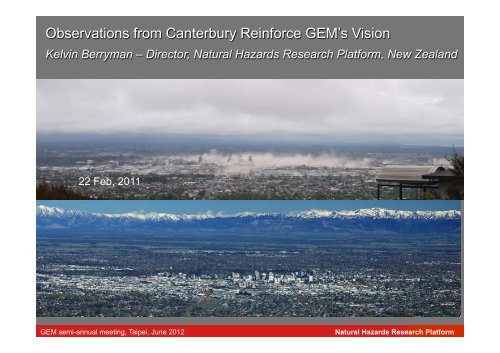
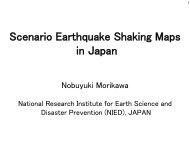
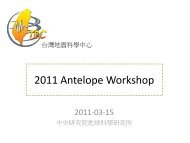
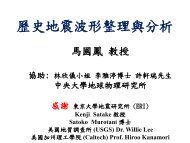



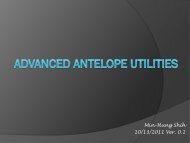
![Ching et al. [2011]](https://img.yumpu.com/47779892/1/190x143/ching-et-al-2011.jpg?quality=85)

